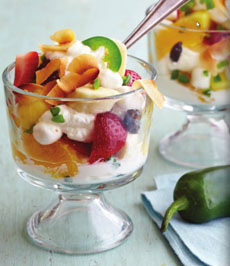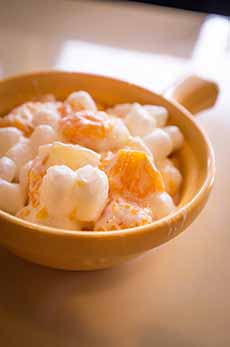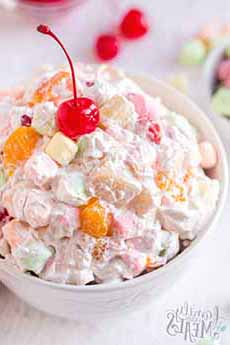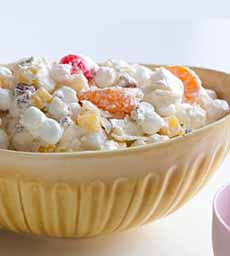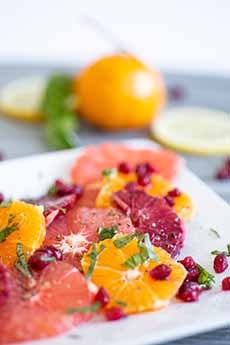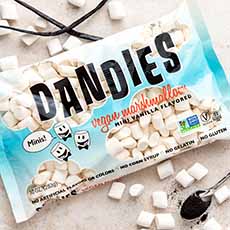RECPE: Ambrosia Salad For Fall & Winter
|
|
In Greek mythology, the gods ate ambrosia and drank nectar, fragrant foods that were typically reserved for divine beings. Mortals would face death if they dared to eat either. While no descriptions of either these foods survive (the word ambrosia means delicious or fragrant and nectar indicates a delicious or invigorating drink), scholars have long believed that both ambrosia and nectar were based on honey. (Mead, popular with the ancients, is a fermented honey drink.) Modern ambrosia is a variation on a traditional fruit salad. Two recipes follow: our own customizable one, and another one below, from Alton Brown. It originated in the southern U.S. in the last quarter of the 19th century, when oranges became more available in markets across the country. The original recipes were simple layerings of grated coconut, sliced oranges, and powdered sugar, served in a glass dish. The recipe became popular in the early part of the twentieth century, according to FoodTimeline.org. Many variations proliferated. Today, it’s a retro recipe that is too often laden with maraschino cherries, canned pineapple, and whipped topping—and it justifiably gets a bad rap. In addition to the coconut, orange/mandarin, and pineapple, ambrosia recipes often contain miniature marshmallows and maraschino cherries. But make it with the best ingredients, and you’ve got but a fun fruit salad substitute for the colder months, when primo fresh fruit options are fewer. (Some recipes use canned pineapple and mandarin segments. Trust us, if you have a good palate, you’ll want to use fresh fruit.) You can serve ambrosia as a first course atop mesclun or lettuce leaves, as a side dish with ham or turkey, or as dessert. December 12th is National Ambrosia Day. This is a customizable recipe. You can create the classic layered dish—shredded coconut (instead of grated), sliced oranges, and pineapple on their own. You can add a binder: mayonnaise (ideally mixed with one of the following), sour cream, vanilla yogurt, whipped cream (lightly sweetened or unsweetened). We’ve also seen recipes that use cream cheese, cottage cheese, and for a dessert version, vanilla pudding. You can combine them to suit your palate. The Alton Brown recipe, below, dilutes sour cream with heavy cream. So what should your ambrosia salad be? Use the classics—oranges, pineapple, coconut—with any of the following ingredients and your binder of choice. Ingredients You can layer the ingredients in a glass bowl, as originally done. Or you can mix them up, like a conventional fruit salad. For the latter: 1. ADD all ingredients except the garnishes in a mixing bowl. Toss to blend and add your binder to the desired level of creaminess. Fold in until evenly distributed. Refrigerate until ready to serve. 2. TRANSFER to a serving bowl or individual serving dishes. Garnish as desired. This recipe is adapted from an Alton Brown version. It is best served on the day of preparation. The sugar can cause the oranges (and other fruits) to release their juices and the dish can turn to mush. This recipe is adapted from Alton Brown’s and is so easy that you can assign it to an older child to prepare. Prep time is 30 minutes, plus two hours of chilling. Ingredients For 6 Servings 6 clementines) 1. PLACE the cream and sugar into the bowl of a stand mixer with the whisk attachment and whip until stiff peaks are formed. Add the sour cream and whisk to combine. 2. ADD the marshmallows, orange, pineapple, coconut, pecans, and cherries; stir to combine. 3. TRANSFER to a glass serving bowl, cover, and refrigerate for 2 hours before serving. *The best maraschino cherries, worth of a connoisseur, are from Tillen Farms, all natural and made with sugar instead of corn syrup. †You can make brandied cherries even out of season: Just use frozen cherries. Here’s the recipe. |
|
|
|
||
